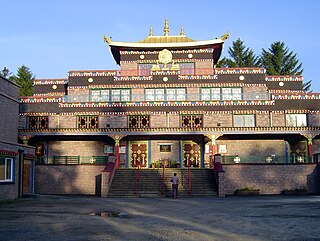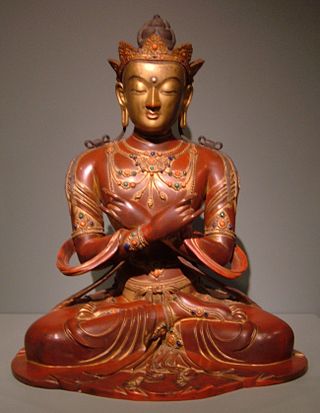
Tibetan Buddhism is the form of Buddhism practiced in the regions of Tibet and Mongolia. It is also practiced in regions surrounding the Himalayas such as Ladakh, Lahaul and Spiti, Sikkim, Arunachal Pradesh of India, Bhutan and parts of Nepal, in places of Central Asia, Xinjiang, Inner Mongolia and in some regions of Russia.

The Kagyu school, also transliterated as Kagyü, or Kagyud, which translates to "Oral Lineage" or "Whispered Transmission" school, is one of the main schools of Tibetan Buddhism. The Kagyu lineages trace themselves back to the 11th century Indian Mahasiddhas Naropa, Maitripa and the yogini Niguma, via their student Marpa Lotsawa (1012–1097), who brought their teachings to Tibet. Marpa's student Milarepa was also an influential poet and teacher.

In Buddhism, Avalokiteśvara is a bodhisattva who embodies the compassion of all Buddhas and is the principal attendant of Amitabha Buddha at the right. He has 108 avatars, one notable avatar being Padmapāṇi. He is variably depicted, described, and portrayed in different cultures as either male or female. In East Asian Buddhism, he has evolved into a female form called Guanyin.

Kagyu Samye Ling Monastery and Tibetan Centre is a Tibetan Buddhist complex associated with the Karma Kagyu school located at Eskdalemuir, Scotland.
Tai Situpa is a leading incarnate lama tulkus in the Kagyu school of Tibetan Buddhism In Tibetan Buddhism tradition, Kenting Tai Situpa is considered as emanation of Bodhisattva Maitreya and Guru Padmasambhava and who has been incarnated numerous times as Indian and Tibetan yogis since the time of the historical Buddha.

Jetsun Milarepa was a Tibetan siddha, who was famously known as a murderer when he was a young man, before turning to Buddhism and becoming a highly accomplished Buddhist disciple. He is generally considered one of Tibet's most famous yogis and spiritual poets, whose teachings are known among several schools of Tibetan Buddhism. He was a student of Marpa Lotsawa, and a major figure in the history of the Kagyu school of Tibetan Buddhism. He is also famous for the feat of climbing Mount Kailash.

The Rimé movement is a movement or tendency in Tibetan Buddhism which promotes non-sectarianism and universalism. Teachers from all branches of Tibetan Buddhism - Sakya, Kagyu, Nyingma, Jonang and Gelug, as well as Bon - have been involved in the promoting Rimé ideals.

Thrangu Rinpoche was born in 1933 in Kham, Tibet. He is deemed to be a prominent tulku in the Kagyu school of Tibetan Buddhism, the ninth reincarnation in his particular line. His full name and title is the Very Venerable Ninth Khenchen Thrangu Tulku, Karma Lodrö Lungrik Maway Senge. The academic title Khenchen denotes great scholarly accomplishment, and the term Rinpoche is a Tibetan devotional title which may be accorded to respected teachers and exemplars.

Nāropā or Abhayakirti was an Indian Buddhist Mahasiddha. He was the disciple of Tilopa and brother, or some sources say partner and pupil, of Niguma. As an Indian Mahasiddha, Naropa's instructions inform Vajrayana, particularly his six yogas of Naropa relevant to the completion stage of anuttarayogatantra. He was also one of the gatekeepers of Vikramashila monastery which is located in Bihar.

The Buddhist flag is a flag designed in the late 19th century as a universal symbol of Buddhism. It is used by Buddhists throughout the world.

Mahākāla is a deity common to Hinduism and Tantric Buddhism. In Buddhism, Mahākāla is regarded as the sacred Dharmapāla, while in Hinduism, Mahākāla is a fierce manifestation of the Hindu god Shiva and the consort of the goddess Mahākālī; he most prominently appears in the Kalikula sect of Shaktism. Mahākāla also appears as a protector deity in Vajrayana, Chinese Esoteric, and Tibetan Buddhism, and also in the Chàn and Shingon traditions. He is known as Dàhēitiān and Daaih'hāktīn in Mandarin and Cantonese, Daeheukcheon (대흑천) in Korean, Đại Hắc Thiên in Vietnamese, and Daikokuten in Japanese.

Vajradhara is the ultimate primordial Buddha, or Adi-Buddha, according to the Sakya, Gelug and Kagyu schools of Tibetan Buddhism. It is also a name of Indra, because "Vajra" means diamond, as well as the thunderbolt, or anything hard more generally.

Benalmádena Stupa is a stupa in Benalmádena, Málaga in the Andalusian region of southern Spain, overlooking Costa del Sol. It is 33 m (108 ft) high and is the tallest stupa in Europe. It was inaugurated on 5 October 2003, and was the final project of Lopon Tsechu Rinpoche.

Although there was regular contact between practising Buddhists and Europeans in antiquity the former had little direct impact. In the latter half of the 19th century, Buddhism came to the attention of Western intellectuals and during the course of the following century the number of adherents has grown. There are now between 1 and 4 million Buddhists in Europe, the majority in Italy, Germany, France and the United Kingdom.

Monlam also known as The Great Prayer Festival, falls on 4th–11th day of the 1st Tibetan month in Tibetan Buddhism.

Pema Dönyö Nyinje Wylie: pad+ma don yod nyin byed, born 1954 is the 12th Tai Situpa, a tulku in Tibetan Buddhism, and one of the leading figures of the Karma Kagyu school. He is the head of Palpung Monastery.

The Pagode du bois de Vincennes is the seat of the Institut international bouddhique founded by Jean Sainteny who was the manager of the institute. It is located in a former building of the exposition coloniale de 1931, designed by the architect Louis-Hippolyte Boileau. On this 8 000 m² site on the edge of the lac Daumesnil are located two buildings of remarkable architecture. The most important one, the former house of Cameroon, was restored in 1977 and transformed in a pagoda as a place of worship. The second is the former house of Togo is slated for restoration by the City of Paris. It will contain a library for texts on the various Buddhist traditions.

Ka-Nying Shedrub Ling is a Tibetan Buddhist monastery near Boudhanath, on the outskirts of Kathmandu, Nepal. It has ties to both the Kagyu and Nyingma schools, hence the combined Ka-Nying in the name. Shedrub Ling means “sanctuary for learning and practice.”
















